Other common names:
- Black nightshade: deadly nightshade, poison berry, garden nightshade, hound’s berry, garden huckleberry
- Eastern black nightshade: deadly nightshade, poison berry, garden nightshade, West Indian nightshade
- Hairy nightshade: No other common names located
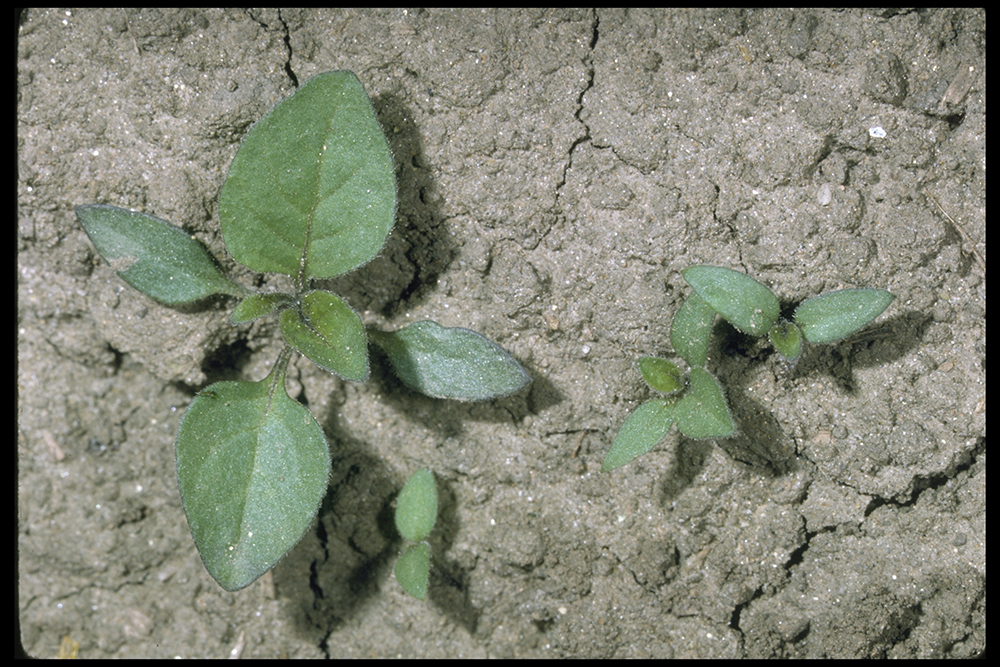
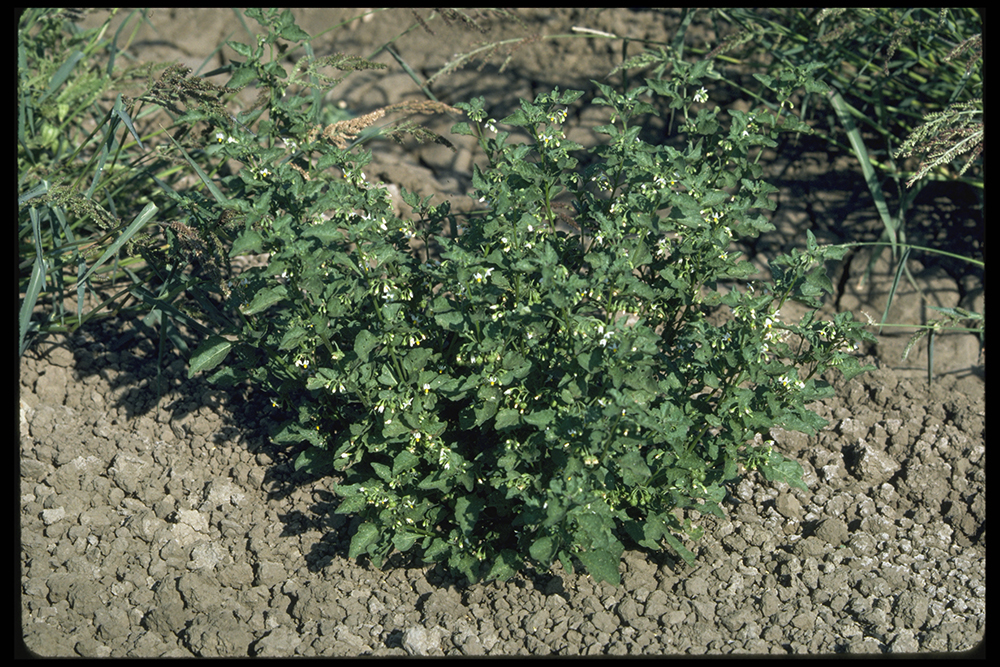
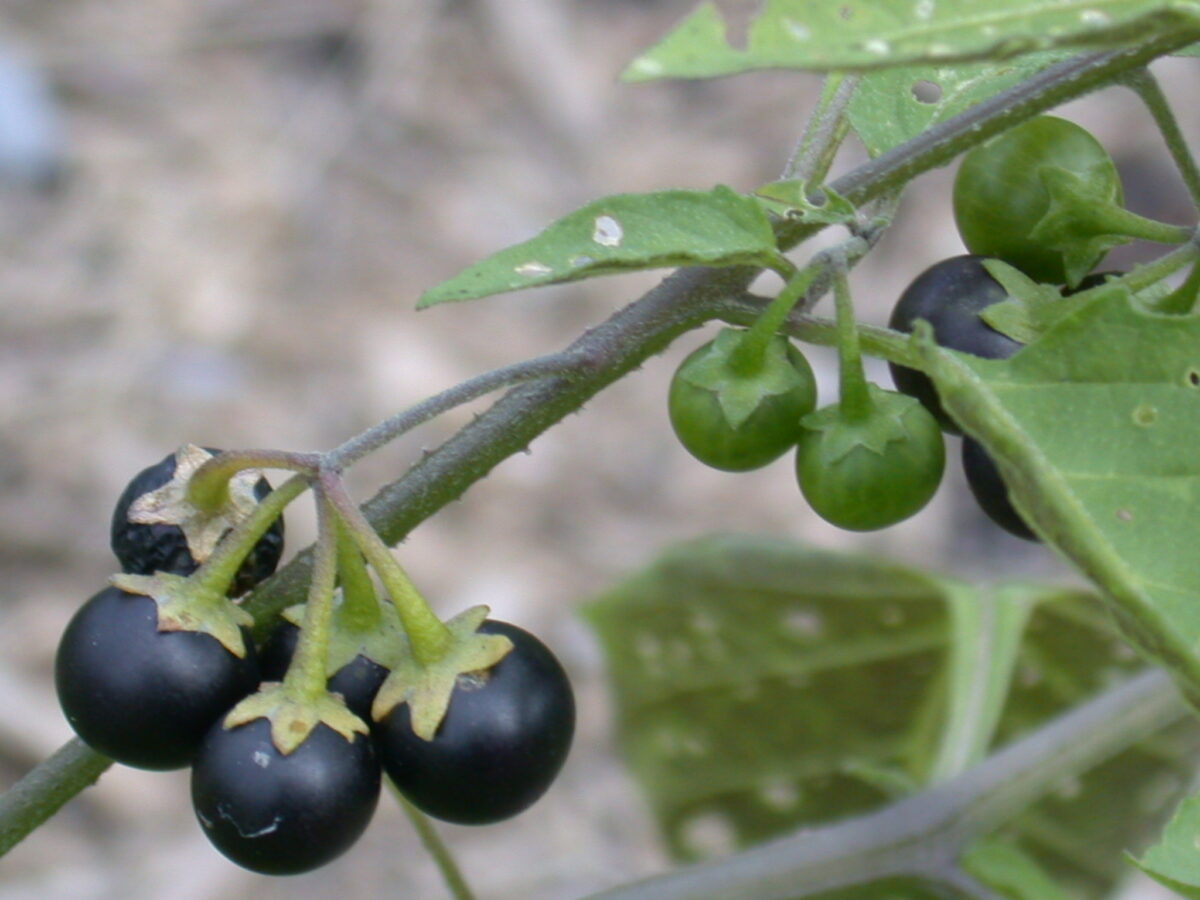
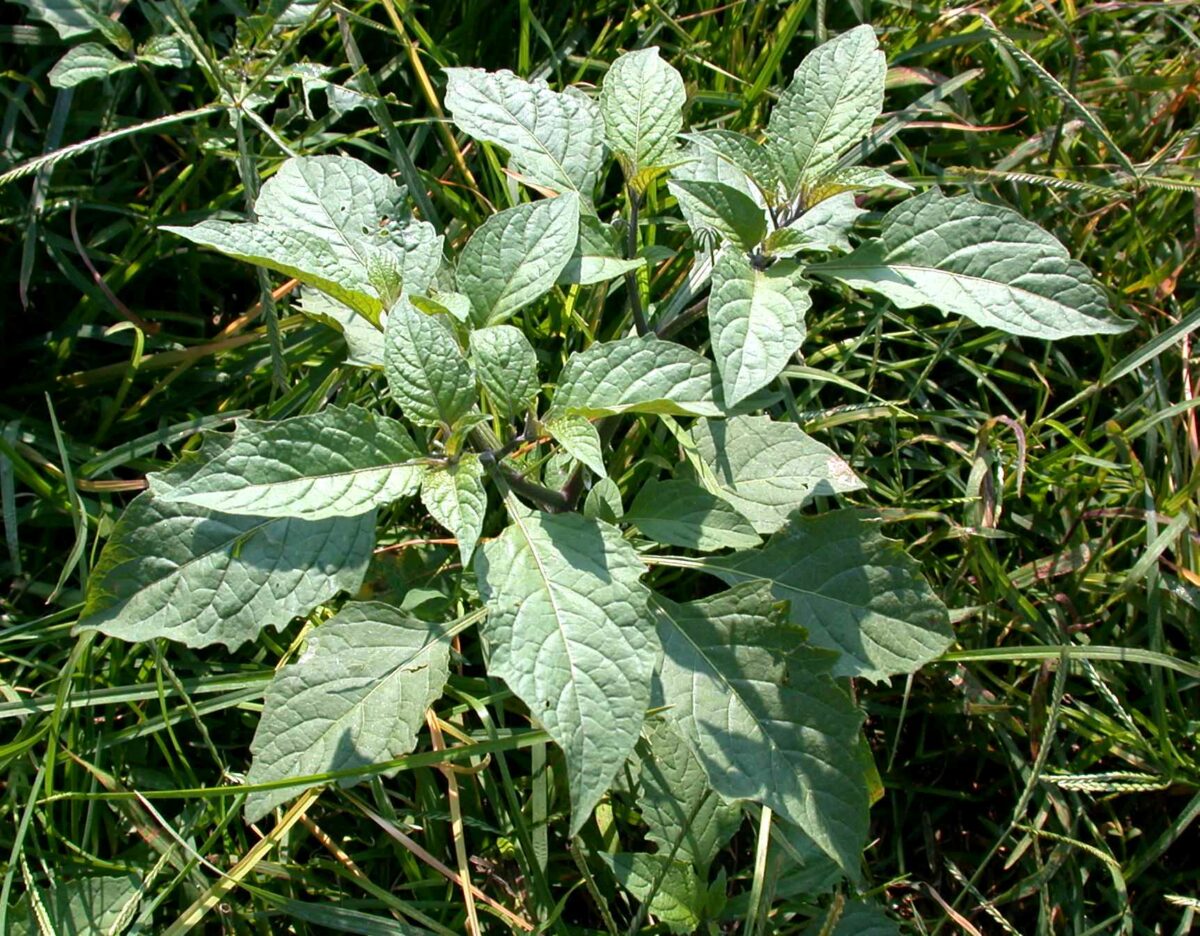
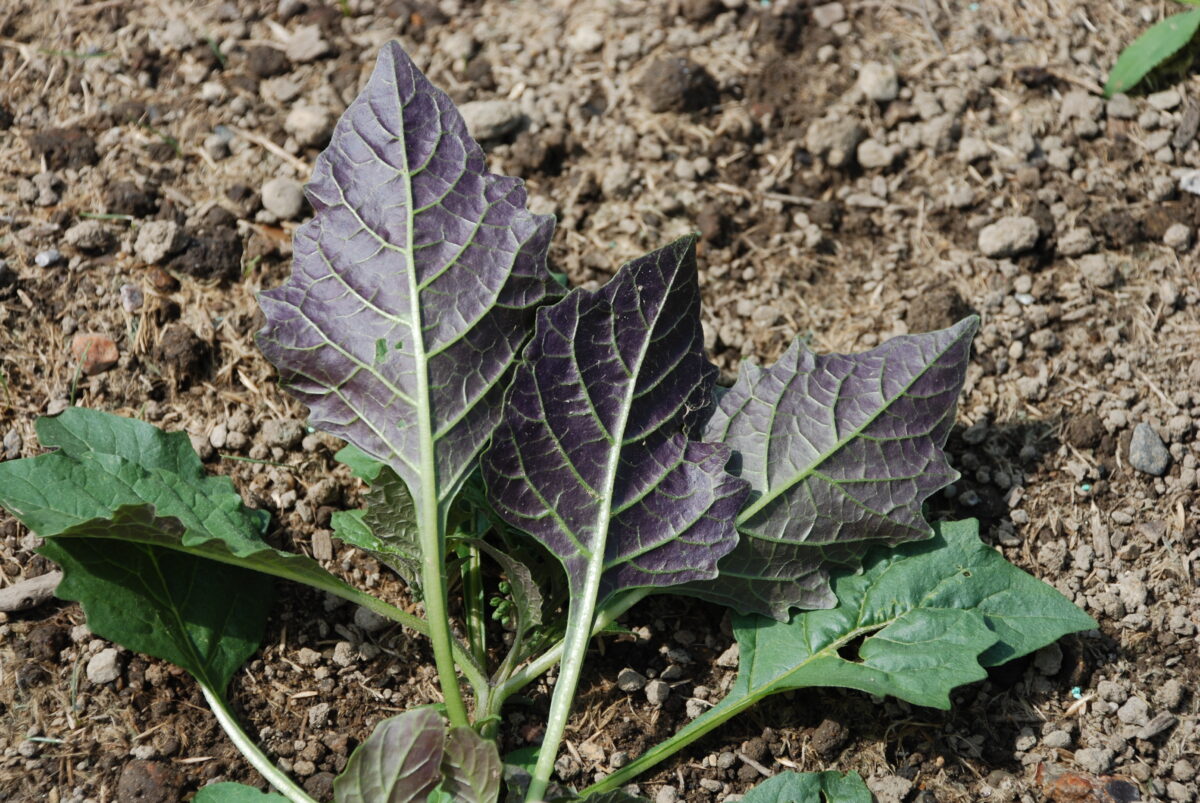
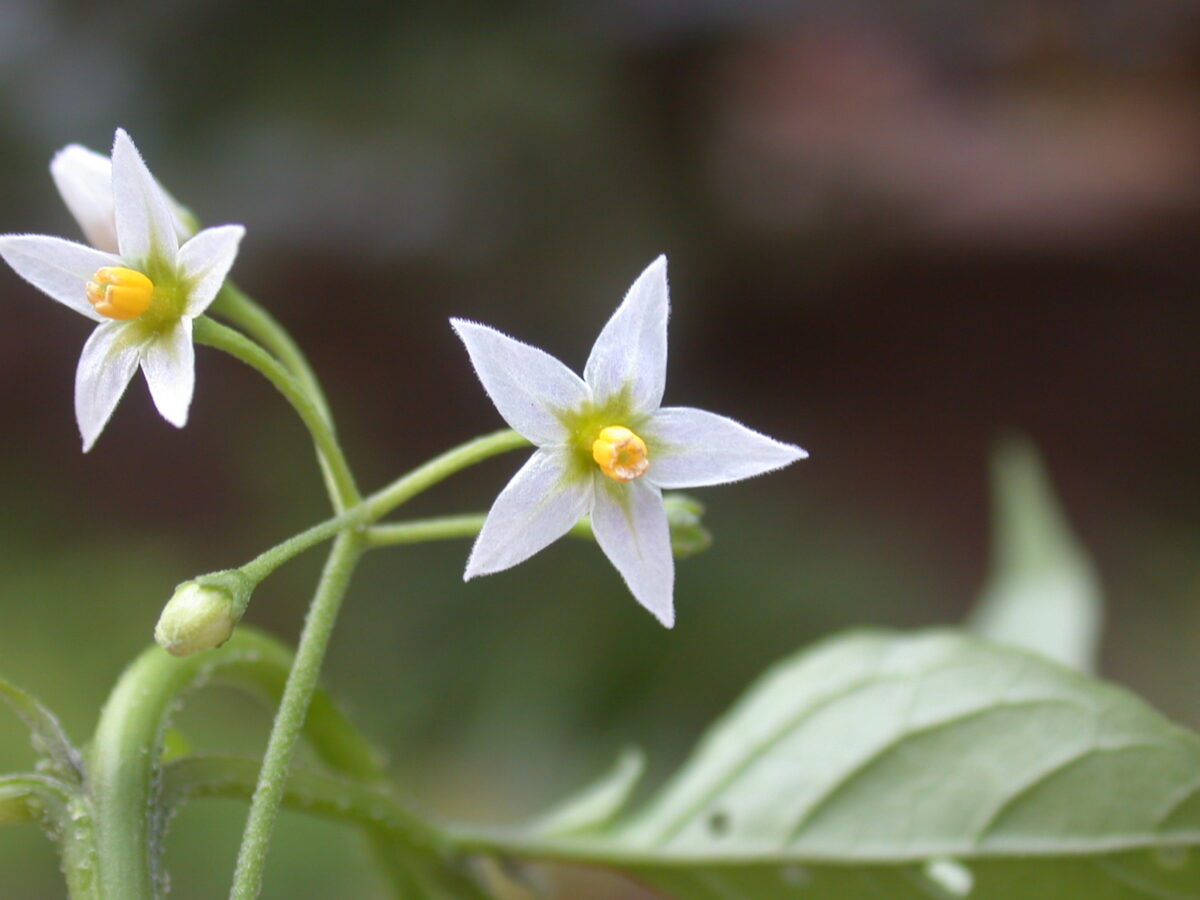
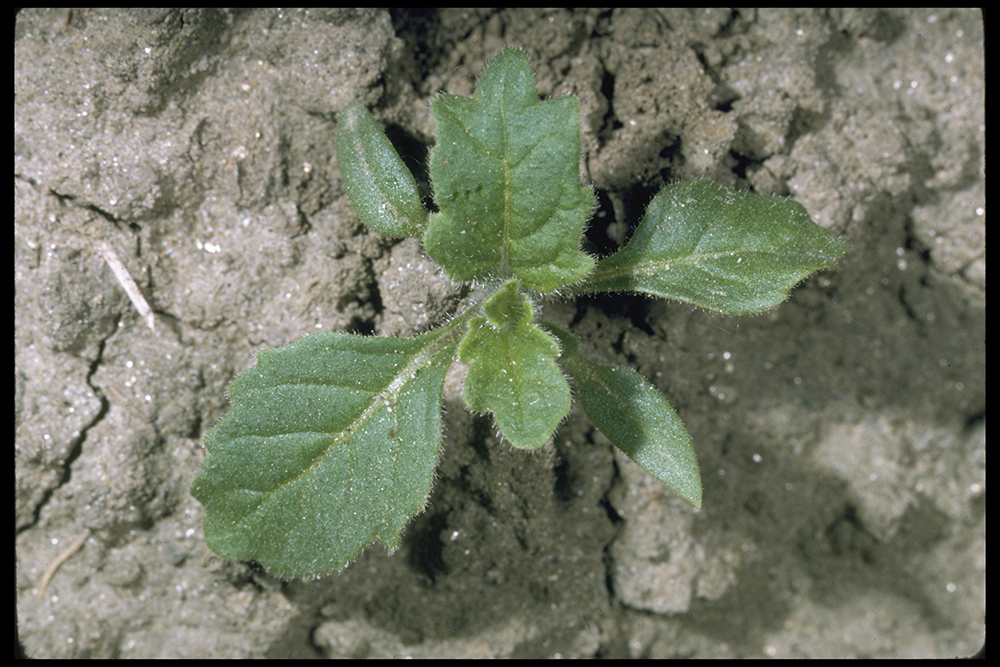
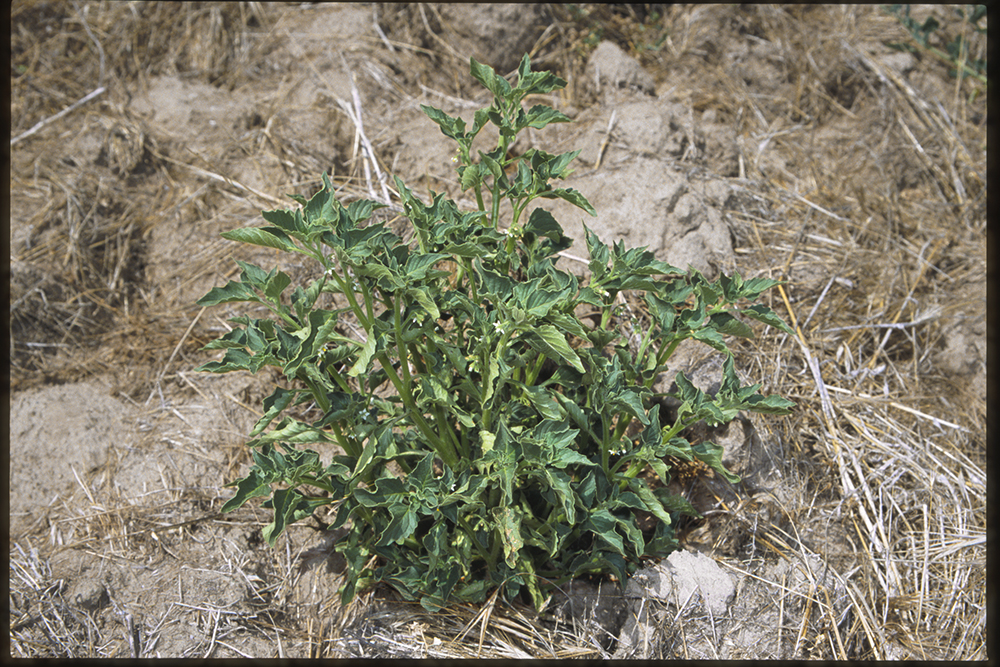
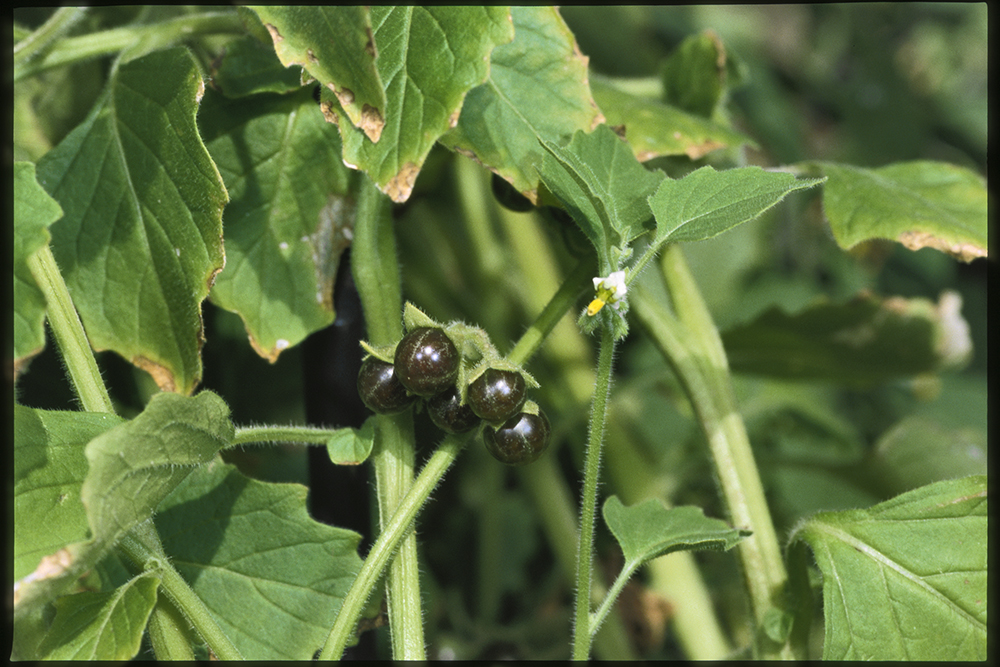
Black nightshade, Solanum nigrum L.
Eastern black nightshade, Solanum ptycanthum Dunal
Hairy nightshade, Solanum physalifolium Rusby = S. sarachoides auct. non Sendtn.
Identification of Nightshades
Family: Nightshade family, Solanaceae
Habit: Erect, branched, summer annual herbs
Description: Seedlings have egg-shaped to lanceolate cotyledons. The stem of the seedling is hairy. Young leaves are alternate.
- Black nightshade: Cotyledons are 0.1–0.4 inch long by 0.1 inch wide and pointy tipped with small, sticky hairs on the leaf edges, below the midvein and scattered on the leaf surface. The first leaf is spade shaped, and subsequent leaves are oval or egg shaped. Young, light green leaves are wavy and hairy on all surfaces and edges, with prominently veined, purple tinged undersides.
- Eastern black nightshade: Cotyledons are 0.4–0.5 inch long by 0.1–0.2 inch wide on 0.1–0.2 inch-long stalks and have green upper surfaces and green to maroon, prominently veined undersides. The stem of the seedling is green with a red hue. Stems and stalks above the cotyledons are purplish, with absent or inconspicuous hairs. Young leaves are egg shaped and nearly hairless, with wavy edges and purple-tinged undersides.
- Hairy nightshade: Cotyledons are egg shaped to lanceolate, 0.17–0.4 inch long and green on both surfaces, with hairs on leaf edges and stalks. Young leaves are oval to elliptical, wavy edged and hairy.
Mature plants have round, ridged, woody, green stems. Leaves are stalked and alternate on the stem. When present, toothing is coarse, irregularly spaced and rounded. Fibrous roots branch from the shallow taproot.
- Black nightshade: Branching begins low on the stem, and stems can reach 1.75–3 feet tall. Dark green leaves are 1–5 inches long by 0.5–2.5 inches wide, oval to egg shaped, with wavy sides that taper to a tip. Edges have purple undersides. Lower leaves have teeth, but upper leaves do not. Sparse, non-sticky hairs are typically present on stems, leaf undersides and leaf stalks.
- Eastern black nightshade: Stems are hairless to lightly hairy and can reach 1–3.3 feet. Leaves are 1–3 inches long by 0.4–2.25 inches wide and elliptical to triangular egg shaped. Leaves are nearly hairless. Edges are toothed, wavy and red-purple underneath.
- Hairy nightshade: Stems are slender, often coated in sticky, spreading hairs and typically reach 1–2 feet but sometimes 3 feet in height. Leaves are egg shaped to lanceolate, 0.75–3 inches long by 0.25–2.25 inches wide, with fine, spreading hairs on the undersides of large veins and sometimes on leaf surfaces. Leaf margins are lightly toothed or untoothed.
Flowers are star shaped, individually stalked and made up of five fused petals and a cone of yellow anthers; flowers have five small, green sepals at the flower base and are clustered.
- Black nightshade: Each cluster has five to 10, white to pale blue, drooping, 0.25–0.4 inch-wide flowers. Flower stalks arise from an unbranched central axis.
- Eastern black nightshade: Each cluster has four to seven drooping, white to light purple, 0.25–0.4 inch flowers. Flower stalks arise from a common point.
- Hairy nightshade: Each cluster has four to five, white, 0.3–0.5 inch-wide flowers. The flower stalks generally arise from an unbranched central axis but occasionally can arise from a common point.
Fruit and seeds: Berries are green when immature. Seeds are flat.
- Black nightshade: Dull, blue-black berries are 0.4–0.6 inch wide and each contains 15–60 yellow to light brown (sometimes white), pointed, oval, 0.06 inch-long seeds. Berries fall off the plant before the first frost. Berries are not enclosed by sepals.
- Eastern black nightshade: Shiny, purple-black berries are 0.4 inch wide, and each contains 50–110 round, yellow to white, dull, 0.06–0.08 inch-long seeds. Berries are retained after the first frost and are not enclosed by sepals.
- Hairy nightshade: Yellow-green to olive or slightly purple-green berries are 0.2–0.4 inch wide, and each contains 10–36 round or oval, 0.07–0.09 inch-diameter, tan seeds. Berries are partially enclosed by sepals.
Similar species: Silverleaf nightshade (Solanum elaeagnifolium Cav.) is a perennial with large, showy purplish flowers, thorny stems and gray-green leaves, and it spreads by storage roots. American black nightshade (Solanum americanum Mill.) has wide cotyledons, hairless stems and leaves that have no or only shallow toothing; its habit is upright, but its branches are closely clumped, not spreading. Leaves and flowers of horsenettle (Solanum carolinense L.) are similar, but it is a perennial with large, sharp spines on stems and leaves, and it spreads by underground storage roots. Bittersweet nightshade (Solanum dulcamara L.) is a larger, vining perennial with red berries.
Management of Nightshades
Black nightshades not only compete with crops and reduce crop yields but also interfere with harvest and lower crop quality. The berries stain and cause soil to stick to beans, thereby causing much crop loss. They are impossible to separate from peas, leading to downgrading of the crop. The berries also add moisture to a range of combine harvested crops, leading to growth of molds. Normal tillage and cultivation practices are usually sufficient to keep light infestations under control. When growing dry beans, food grade soybeans or peas, however, eradicate any newly established populations and attack established populations with all measures available. Avoid excessive N as this will favor these weeds relative to most crops. Use good cropping practices, relatively high seeding rates and narrow row spacing to get dense, uniform stands that will suppress nightshade. Soil disturbance promotes nightshade emergence, and when practical, no-till systems can reduce nightshade densities. These species form moderately persistent seed banks, but they germinate throughout spring and summer in response to tillage. Consequently, the seeds are relatively easy to flush out of the soil with tilled fallow periods interspersed into the crop rotation or with short cycle vegetable crops in which the weeds do not have time to produce mature fruits. Sod crops set back populations of these weeds since they do not tolerate repeated mowing or competition from the perennial forages. In pastures these nightshades can be controlled by avoiding overgrazing. Intensive rotational grazing is especially effective since the repeated grazing episodes will destroy successive flushes of seedlings.
These weeds harbor many diseases and insect and nematode pests of solanaceous crops like potatoes, tomatoes and peppers. If they are allowed to grow during break periods between these crops, they will cancel many of the benefits of crop rotation for disease and pest control. Consequently, escapes should be hand rogued out of break crops and removed from the field.
Solarization to temperatures of 122–131°F for at least two days completely inhibits germination of these species from the upper soil layer.
Ecology of Nightshades
Origin and distribution: Black nightshade was apparently introduced from Europe. It occurs on the East Coast and West Coast but is primarily a problem on the West Coast. It also occurs in Asia, Africa, Australia, and South and Central America. Eastern black nightshade is native to eastern North America and is the most common member of the black nightshade group east of the Rocky Mountains. Hairy nightshade is a native of southern South America that has been introduced into North America, Europe, Africa, Australia and New Zealand. In North America it occurs throughout most of southern Canada and the United States except the Deep South. It is most common, however, in the prairie region and the Pacific Northwest.
Seed weight: Mean population seed weights for black nightshade range from 0.80–1.3 mg, whereas mean seed weight for eastern black nightshade is 0.43 mg.
Dormancy and germination: The percentage of fresh black nightshade seeds that are dormant varies with the population, and some populations have little or no dormancy once they are separated from the berry. As little as one week of wet storage at 40–59°F is sufficient to break dormancy. Black nightshade seeds germinate best with fluctuating temperatures with an amplitude of 9–27°F and including a high temperature of 77–86°F. Constant temperatures may result in poor germination. However, some studies have found good germination at constant temperatures of 77–86°F provided seeds received a pretreatment with wet, cool conditions to reduce dormancy. The base temperature for germination is 46–50°F. Hot summer temperatures (e.g., 93–100°F) induce secondary dormancy. Nitrate and light promote germination of black nightshade. Light is a requirement for germination at constant temperature but is less important at alternating temperatures.
Eastern black nightshade germinates best in light at temperatures from 77–86°F or with alternating temperatures including a high temperature of 86°F. Several days’ exposure to full sunlight, however, completely inhibits germination. Nitrate increases germination of seeds that have been exposed to light. The base temperature for emergence is 52–55°F. Eastern black nightshade requires several more days to emerge than other weeds and tomatoes. Germination is optimum at pH 5–8.
Hairy nightshade seeds are usually dormant initially but lose dormancy after 1–6 months, under a wide range of conditions. Seeds germinate well at 77–92°F but poorly at 50–73°F and at 97°F. Fluctuating temperatures increase germination of seeds that have not fully after-ripened by lowering the base temperature from 70°F to 54°F. Seeds of black and hairy nightshade enter a secondary dormancy in late summer/early fall.
Given their seed germination characteristics, stimulation of emergence of these nightshade species by tillage is not surprising.
Seed longevity: Black nightshade seeds can survive up to 39 years in undisturbed soil. Experiments in annually tilled soil, however, showed numbers of black nightshade seeds declined by 37% per year. Under similar tilled conditions, average seed losses over a five-year period were 28% and 45% per year. Hairy nightshade appears to be less persistent than black nightshade, but at least a few seeds last up to five years in the soil. All hairy nightshade seeds survived one year in experiments at two locations in Nebraska, but survival dropped to 11% and lower after two and subsequent years at one location, whereas it remained at 65% after 17 years at the other location.
Season of emergence: The black nightshades begin emerging in mid-spring and continue through summer whenever moisture is adequate. Eastern black nightshade was classified as a late-emerging species in comparison to seven other common weeds in the mid-Atlantic states, but it was classified as a middle-emerging weed with a longer emergence period than most other species in Nebraska. Emergence of nightshades tends to peak in spring when air temperature reaches 68°F or when mean soil temperatures reaches approximately 59°F with an amplitude of 18°F.
Emergence depth: Black nightshade emerges well from seeds within the top 1.6 inch of soil. A few seedlings can emerge from seeds at 2.4–3.1 inches but none from seeds at 4 inches. Eastern black nightshade emerged better from the soil surface than from a 0.6 inch depth, probably due to its smaller seeds.
Photosynthetic pathway: C3
Sensitivity to frost: Black nightshade plants are sensitive to even light frost, but hairy and eastern black nightshades are more tolerant to light frost. The seeds of black and eastern black nightshades do not tolerate cold temperatures such as are found during winter on the Canadian prairies, but hairy nightshade seeds can tolerate such conditions.
Drought tolerance: All three species require moist soil for good growth. They wilt quickly when water stressed but may recover again if the drought period is short. Black and eastern black nightshades are generally absent from regions with dry climates except in irrigated fields, but hairy nightshade tolerates drier conditions.
Mycorrhiza: Black nightshade is mycorrhizal.
Response to fertility: These species are highly responsive to N and P fertility and will store excess N as nitrate. For example, black nightshade accumulated more than twice as much nitrate at the flowering stage as tomatoes and peppers, and the uptake of major nutrients by these crops was reduced when competing with eastern black nightshade. Hairy nightshade plants increased in size up to nitrogen application rates of 430 pounds per acre with a relative response that was similar to wheat. The species showed the strongest response to increasing P levels of 22 weeds and two crops tested. The black nightshades grow best at a pH of 6–6.5.
Soil physical requirements: These species will grow on a wide range of soil textures from sandy loam to clay, but they do best on fertile soils with good moisture holding capacity. They do not tolerate poor drainage.
Response to shade: Eastern black nightshade tolerates only light shade. Shade levels of 60%, 80% and 94% relative to full sunlight reduced growth by 48%, 83% and 98%, and berry production by similar amounts. Plants within soybean rows were only one third as large as plants between the rows. However, even the smallest plants subjected to the most shade produced some seeds to replenish the seed bank. Black nightshade is more shade tolerant than eastern black. For example, moderate shade of 50–60% had little effect on plant biomass and increased the leaf area of black nightshade, but greater than 75% shade reduced all measures of plant size. In hot dry conditions, partial shade appears to promote growth and survival of black nightshade.
Sensitivity to disturbance: Plants resprout vigorously following severe and repeated cutting.
Time from emergence to reproduction: Black nightshade plants emerging in spring require seven to nine weeks before flowering. In mid-summer, flowers begin opening five to six weeks after emergence. Eastern black nightshade flowered five to 10 weeks after emergence. Nightshade berries mature four to five weeks after pollination, although maximum seed viability of eastern black nightshade was not reached until six to eight weeks after flowering. Fruit production in all species continues until frost.
Pollination: All three species commonly self-pollinate but also are cross pollinated by insects.
Reproduction: Eastern black nightshade plants growing outside in Ontario produced 50–100 berries and at least 2,500–5,000 seeds each. In Minnesota, eastern black nightshade without competition produced 2,700–7,400 berries containing 252,000–825,000 seeds per plant. However, maximum seed production with soybean competition was 2,500 seeds per plant. In Illinois, individual plants produced 6,000 berries with 500,000 seeds under the most favorable conditions. In California, black nightshade averaged 60 seeds per berry and 60,000 seeds per plant, whereas hairy nightshade averaged 20 seeds per berry and 16,000 seeds per plant. Black nightshade berries fall off the plant when mature, but eastern black nightshade plants remain upright with some berries intact on the plant after frost has killed the plants.
Dispersal: Seeds of all three species are spread by birds, rodents and livestock that eat the berries. The seeds pass unharmed through the bird and mammal digestive tracts. The berries also disperse by water as well as with hay, straw or crop seed.
Common natural enemies: The nightshades are attacked by Colorado potato beetles (Leptinotarsa decemlineata), tobacco and potato flea beetles (Epitrix hirtipennis and E. cucumeris) and spinach leaf miners (Pegomya hyoscyami). They also host bean aphids (Aphis fabae), which can cause leaf curling and death of nightshade shoot tips. Like domesticated species in the nightshade family, these weedy nightshades are attacked by many fungal and viral diseases.
Palatability: Berries and foliage can be poisonous to humans and livestock, and immature berries are particularly toxic. Nightshade plants mixed with forage remains poisonous and can cause intestinal dysfunction and many other symptoms in livestock. Toxicity is associated with alkaloids and high accumulations of nitrate. However, concentration of the toxic principles apparently varies greatly and is reduced in boiled leaves and ripe berries. The nutritional value of leaves and berries is generally high, although it can vary depending on soil fertility, age and species. In the United States, the berries of these weeds are sometimes used to make jam. In Africa, Central America and southeast Asia, people eat the fruit of black nightshade and use the leaves as a cooked vegetable. Domesticated varieties of black nightshade are grown for the fruit and leaves in many countries and are called “garden huckleberry” in the United States. Leaves of plants grown in shade were considered more palatable and less bitter than leaves grown in full sun.
Summary Table of Nightshades Characteristics
| Nightshades | ||||||||
|---|---|---|---|---|---|---|---|---|
| Growth habit | Seed weight (mg) | Seed dormancy at shedding | Factors breaking dormancy | Optimum temperature for germination (F) | Seed mortality in untilled soil (%/year) | Seed mortality in tilled soil (%/year) | Typical emergence season | Optimum emergence depth (inches) |
| short, branched | 0.4–1.3 | Variable | cms, li, at, ni | 77–86 | 15 | 28–45 | mid-spring to summer | 0–1.6 |
| Photosynthesis type | Frost tolerance | Drought tolerance | Mycorrhiza | Response to nutrients | Emergence to flowering (weeks) | Flowering to viable seed (weeks) | Pollination | Typical & high seed production (seeds per plant) |
| C3 | low | low | yes | high | 5–10 | 4–8 | self, can cross | 10,000 & 500,000 |
Table Key
General: The designation “–” signifies that data is not available or the category is not applicable.
Growth habit: A two-word description; the first word indicates relative height (tall, medium, short, prostrate) and second word indicates degree of branching (erect, branching, vining).
Seed weight: Range of reported values in units of “mg per seed.”
Seed dormancy at shedding: “Yes” if most seeds are dormant when shed, “Variable” if dormancy is highly variable, “No” if most seeds are not dormant.
Factors breaking dormancy: The principle factors that are reported to break dormancy and facilitate germination. The order of listing does not imply order of importance. Abbreviations are:
scd = seed coat deterioration
cms = a period subjected to cold, moist soil conditions
wst = warm soil temperatures
li = light
at = alternating day-night temperatures
ni = nitrates
Optimum temperature range for germination: Temperature (Fahrenheit) range that provides for optimum germination of non-dormant seeds. Germination at lower percentages can occur outside of this range. The dash refers to temperature range, and the slash refers to alternating day/night temperature amplitudes.
Seed mortality in untilled soil: Range of mortality estimates (percentage of seed mortality in one year) for buried seeds in untilled soil. Values were chosen where possible for seeds placed at depths below the emergence depth for the species and left undisturbed until assessment. Mortality primarily represents seed deterioration in soil.
Seed mortality in tilled soil: Range of mortality estimates (percentage of seed mortality in one year) for seeds in tilled soil. Values were chosen for seeds placed within the tillage depth and subjected to at least annual tillage events. Seed losses are the result of dormancy-breaking cues induced by tillage, germination and deterioration of un-germinated seeds.
Typical emergence season: Time of year when most emergence occurs in the typical regions of occurrence for each weed. Some emergence may occur outside of this range.
Optimum emergence depth: Soil depths (in inches below the soil surface) from which most seedlings emerge. Lower rates of emergence usually will occur at depths just above or just below this range.
Photosynthesis type: Codes “C3” or “C4” refer to the metabolic pathway for fixing carbon dioxide during photosynthesis. Generally, C3 plants function better in cooler seasons or environments and C4 plants function better in warmer seasons or environments.
Frost tolerance: Relative tolerance of plants to freezing temperatures (high, moderate, low).
Drought tolerance: Relative tolerance of plants to drought (high, moderate, low).
Mycorrhiza: Presence of mycorrhizal fungi. “Yes” if present; “no” if documented not to be present, “unclear” if there are reports of both presence and absence; “variable” if the weed can function either with or without, depending on the soil environment.
Response to nutrients: Relative plant growth response to the nutrient content of soil, primarily N, P, K (high, moderate, low).
Emergence to flowering: Length of time (weeks) after emergence for plants to begin flowering given typical emergence in the region of occurrence. For species emerging in fall, “emergence to flowering” means time from resumption of growth in spring to first flowering.
Flowering to viable seed: Length of time (weeks) after flowering for seeds to become viable.
Pollination: “Self” refers to species that exclusively self-pollinate, “cross” refers to species that exclusively cross-pollinate, “self, can cross” refer to species that primarily self-pollinate, but also cross-pollinate at a low rate, and “both” refers to species that both self-pollinate and cross-pollinate at relatively similar rates.
Typical and high seed production potential: The first value is seed production (seeds per plant) under typical conditions with crop and weed competition. The second value, high seed production, refers to conditions of low density without crop competition. Numbers are rounded off to a magnitude that is representative of often highly variable reported values.
Further Reading
Bassett, I.J. and D.B. Munro. 1985. The biology of Canadian weeds. 67. Solanum ptycanthum Dun., S. nigrum L. and S. sarrachoides Sendt. Canadian Journal of Plant Science 65: 401–414.
DeFelice, M.S. 2003. The black nightshades, Solanum nigrum L. et al. – poison, poultice, and pie. Weed Technology 17: 421–427.
Peachey, R.E., R.D. William and C. Mallory-Smith. 2004. Effect of no till or conventional planting and cover crops residues on weed emergence in vegetable row crop. Weed Technology 18: 1023–1030.
Rich, A.M. and K.A. Renner. 2007. Row spacing and seeding rate effects on eastern black nightshade (Solanum ptycanthum) and soybean. Weed Technology 21: 124–130.
Stoller, E.W. and R.A. Myers. 1989. Effects of shading and soybean Glycine max (L.) interference on Solanum ptycanthum (Dun.) (eastern black nightshade) growth and development. Weed Research 29: 307–316.

